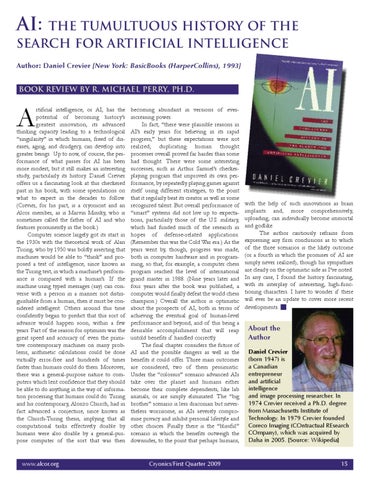AI:
THE TUMULTUOUS HISTORY OF THE SEARCH FOR ARTIFICIAL INTELLIGENCE Author: Daniel Crevier [New York: BasicBooks (HarperCollins), 1993] book review by r. michael perry, ph.d.
A
rtificial intelligence, or AI, has the potential of becoming history’s greatest innovation, its advanced thinking capacity leading to a technological “singularity” in which humans, freed of diseases, aging, and drudgery, can develop into greater beings. Up to now, of course, the performance of what passes for AI has been more modest, but it still makes an interesting study, particularly its history. Daniel Crevier offers us a fascinating look at this checkered past in his book, with some speculations on what to expect in the decades to follow. (Crevier, for his part, is a cryonicist and an Alcor member, as is Marvin Minsky, who is sometimes called the father of AI and who features prominently in the book.) Computer science largely got its start in the 1930s with the theoretical work of Alan Turing, who by 1950 was boldly asserting that machines would be able to “think” and proposed a test of intelligence, since known as the Turing test, in which a machine’s performance is compared with a human’s. If the machine using typed messages (say) can converse with a person in a manner not distinguishable from a human, then it must be considered intelligent. Others around this time confidently began to predict that this sort of advance would happen soon, within a few years. Part of the reason for optimism was the great speed and accuracy of even the primitive contemporary machines on many problems; arithmetic calculations could be done virtually error-free and hundreds of times faster than humans could do them. Moreover, there was a general-purpose nature to computers which lent confidence that they should be able to do anything in the way of information processing that humans could do. Turing and his contemporary, Alonzo Church, had in fact advanced a conjecture, since known as the Church-Turing thesis, implying that all computational tasks effectively doable by humans were also doable by a general-purpose computer of the sort that was then
www.alcor.org
becoming abundant in versions of everincreasing power. In fact, “there were plausible reasons in AI’s early years for believing in its rapid progress,” but these expectations were not realized; duplicating human thought processes overall proved far harder than some had thought. There were some interesting successes, such as Arthur Samuel’s checkerplaying program that improved its own performance, by repeatedly playing games against itself using different strategies, to the point that it regularly beat its creator as well as some recognized talent. But overall performance of “smart” systems did not live up to expectations, particularly those of the U.S. military, which had funded much of the research in hopes of defense-related applications. (Remember this was the Cold War era.) As the years went by, though, progress was made, both in computer hardware and in programming, so that, for example, a computer chess program reached the level of international grand master in 1988. (Nine years later and four years after the book was published, a computer would finally defeat the world chess champion.) Overall the author is optimistic about the prospects of AI, both in terms of achieving the eventual goal of human-level performance and beyond, and of this being a desirable accomplishment that will reap untold benefits if handled correctly. The final chapter considers the future of AI and the possible dangers as well as the benefits it could offer. Three main outcomes are considered, two of them pessimistic. Under the “colossus” scenario advanced AIs take over the planet and humans either become their complete dependents, like lab animals, or are simply eliminated. The “big brother” scenario is less draconian but nevertheless worrisome, as AIs severely compromise privacy and inhibit personal lifestyle and other choices. Finally there is the “blissful” scenario in which the benefits outweigh the downsides, to the point that perhaps humans,
Cryonics/First Quarter 2009
with the help of such innovations as brain implants and, more comprehensively, uploading, can individually become immortal and godlike. The author cautiously refrains from expressing any firm conclusions as to which of the three scenarios is the likely outcome (or a fourth in which the promises of AI are simply never realized), though his sympathies are clearly on the optimistic side as I’ve noted. In any case, I found the history fascinating, with its interplay of interesting, high-functioning characters. I have to wonder if there will ever be an update to cover more recent developments. I
About the Author Daniel Crevier (born 1947) is a Canadian entrepreneur and artificial intelligence and image processing researcher. In 1974 Crevier received a Ph.D. degree from Massachusetts Institute of Technology. In 1979 Crevier founded Coreco Imaging (COntractual REsearch COmpany), which was acquired by Dalsa in 2005. [Source: Wikipedia]
15
